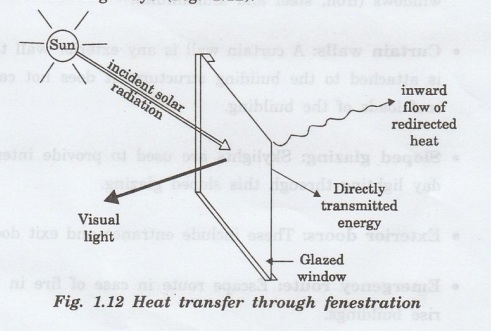Physics For Civil Engineering: Unit I: Thermal Application
Heat Transfer Through Fenestrations
• The short-wave (<25 μm) solar radiation incident on the fenestration system. The part of the incident solar energy is transmitted through opening and eventually absorbed by the room surfaces.
HEAT TRANSFER THROUGH FENESTRATIONS
The heat energy transfer through
fenestration takes place by the following ways (Fig. 1.12).
 •
The
short-wave (<25 μm) solar radiation incident on the fenestration system.
•
The
short-wave (<25 μm) solar radiation incident on the fenestration system.
•
The
part of the incident solar energy is transmitted through opening and eventually
absorbed by the room surfaces.
•
The
part of the incident solar energy is absorbed by the fenestration and
reradiated as thermal energy.
•
The
net long-wave radiation (>2.5 μm wavelength) radiative exchange between
fenestration surroundings.
•
The
conductive and convective heat transfer caused by inside/outside temperature
difference.
Total heat transfer
The total heat transfer through
fenestration consists of two main components:
Qsolar = heat transfer from
solar radiation.
This is always a positive number.
Qthermal = heat transfer
between indoor and outdoor air.
This is positive or negative depending
on temperature.
The total heat transfer through
fenestration
Qtotal = Qsolar + Qthermal
The
first component viz solar heat gain, is present only
during the day when the fenestration (or) building openings are exposed to the
solar radiation and it is therefore related to the intensity of that radiation.
The second component, the transmission
gain, occurs whenever the temperature difference exits, whether the sun is
shining or not, i.e, even during cloudy (or) rainy days.
Physics For Civil Engineering: Unit I: Thermal Application : Tag: : - Heat Transfer Through Fenestrations
Related Topics
Related Subjects
Physics for Civil Engineering
PH3201 2021 Regulation | 2nd Semester Civil Dept 2021 Regulation
